

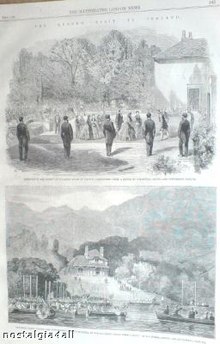
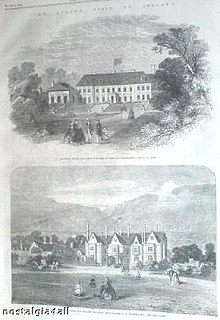

Kenmare House is located on the east shore of Lough Leane and was the principal residence of the Brownes of Killarney, Earls of Kenmare.





Kenmare House is located on the east shore of Lough Leane and was the principal residence of the Brownes of Killarney, Earls of Kenmare.
Sir Valentine Browne and his son, also Valentine Browne, were the first members of the family to settle in Ireland being appointed Surveyor General of Ireland in 1559. Sir Valentine Browne made an agreement with MacCarty Mór for a lease on the lands of Coshmang and Ross in 1588, the year of the Armada. Unlike most of the English settlers since the Reformation, the Brownes soon reverted to the old religion and the family continued to be given the royal title "Viscounts Kenmare" by King James II of England in 1689. It may be remarked here that this title is derived from Kenmare Castle, near Hospital, part of the County Limerick estate of the Browne family, and not, as might naturally be supposed, from the town of that name, which is not actually on the Browne estate. The family's first residence in Killarney was Ross Castle.
The original Kenmare House was built in 1726, after the estates were recovered by the 5th Baronet and 3rd Viscount Kenmare. It was a grandiose structure with the characteristics of a French chateau, perhaps influenced by the Brownes' time spent in France with King James II in exile at Château de Saint-Germain-en-Laye. The house was part of the 137,000-acre estate of the Brownes, who remarkably retained their lands during the Penal Laws as Catholics.
Viscount Kenmare designed the house himself. The house was two stories high and had dormered attics and steep, slated roofs. There were thirteen bays in front of the house, with three bays on each side of the centre breaking forward. A servants' wing was added around 1775.
It is the 4th Viscount Kenmare, Thomas Browne, who is credited with bringing tourism to Killarney. He was also the head of the Catholic Committee. In the years that followed poets such as Tennyson and Wordsworth, and, writers such as Sir Walter Scott and Jane Austen all visited Killarney.
Early writers praised the house: Smith (1756) praised the seat and gardens as did Coquebert (1790), who mentioned that the chimneys were made of marble (rose-coloured and grey and black). O'Donovan (1846) thought it a handsome house, beautifully shaded with trees and shrubs.
On 26 August 1861, Valentine, Lord Castlerosse played host to Queen Victoria and Prince Albert at Killarney. The royal visit put Killarney on the map as a tourist resort and set the scene for the prosperity and popularity it enjoys today. It must also have been the Queen and Prince's last tour together, as the Prince died in December 1861. During the visit of Queen Victoria to Kenmare House, she chose the site of Killarney House, a vast Victorian-Tudor mansion, which was the successor to Kenmare House. In June 1866 King Leopold II of Belgium visited the Kenmares at Killarney.
The original house was demolished in 1872 by the fourth Earl. The succeeding house was accidentally destroyed by fire in 1913 and never rebuilt; instead, the stable block of the original Kenmare House was converted into the present Killarney House, although the Brownes called it Kenmare House. During this time Edward VII and Queen Alexandra and, later, George V and Queen Mary paid visits to the Kenmares in the years before the First World War.
Sir Edwin Lutyens (the architect for Lady Kenmare's brother, the 3rd Lord Revelstoke, at Lambay Castle on Lambay Island, County Dublin) advised Lord Kenmare to build the second Kenmare House in 1915. This house was later abandoned and sold in 1956 to John McShain when a new Kenmare House was built by the heir to the Browne estates, Beatrice Grosvenor (granddaughter of the Duke of Westminster). In 1974, the new manor which was constructed on the site of the former Killarney House by Grosvenor in 1956 was replaced. This last Kenmare House was built on the Killorglin Road, beside the Killarney golf course and the Castlerosse Hotel.
The sale of Kenmare House in 1985 to Denis Kelleher marked the end of the Kenmare family's proprietary connection with Killarney after 450 years.
A €7 million restoration was announced by Leo Varadkar in 2011. [1] [2]
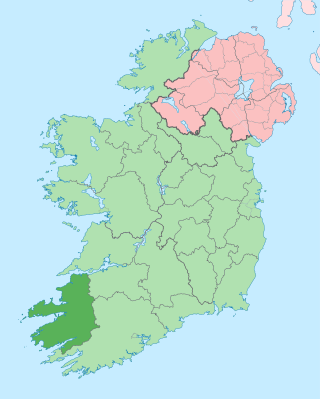
County Kerry is a county in Ireland. It is in the Southern Region and the province of Munster. It is named after the Ciarraige who lived in part of the present county. The population of the county was 156,458 at the 2022 census.

Ross Castle is a 15th-century tower house and keep on the edge of Lough Leane, in Killarney National Park, County Kerry, Ireland. It is the ancestral home of the Chiefs of the Clan O'Donoghue, later associated with the Brownes of Killarney.
Aodhagán Ó Rathaille or Egan O'Rahilly (c.1670–1726), was an Irish language poet. He is credited with creating the first fully developed Aisling.

The title of Earl of Kenmare was created in the Peerage of Ireland in 1801. It became extinct upon the death of the 7th Earl in 1952.

Colonel Valentine Augustus Browne, 4th Earl of Kenmare KP, PC, styled Viscount Castlerosse from 1853 to 1871, was a British courtier and Liberal politician. He held office in every Whig or Liberal administration between 1856 and 1886, notably as Lord Chamberlain of the Household under William Gladstone between 1880 and 1885 and in 1886.
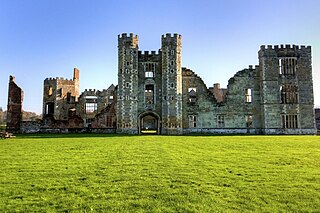
Cowdray House consists of the ruins of one of England's great Tudor houses, architecturally comparable to many of the great palaces and country houses of that time. It is situated in the parish of Easebourne, just east of Midhurst, West Sussex standing on the north bank of the River Rother. It was largely destroyed by fire on 24 September 1793, but the ruins have nevertheless been Grade I listed.
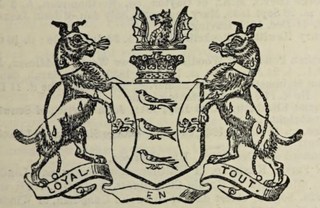
Sir Valentine Browne, of Croft, Lincolnshire, was auditor, treasurer and victualler of Berwick-upon-Tweed. He acquired large estates in Ireland during the Plantation of Munster, in particular the seignory of Molahiffe. He lived at Ross Castle near Killarney, County Kerry. He was MP in three English and one Irish parliaments.

Thomas Browne, 6th Baronet & 4th Viscount Kenmare was an Irish landowner and politician.

Henry Dillon, 11th Viscount Dillon (1705–1787) was an Irish peer and a soldier in French service. He was the colonel proprietor of Dillon's Regiment, an Irish regiment of foot in French service, in 1741–1744 and again in 1747–1767. In the War of the Polish Succession (1733–1735), he fought at the sieges of Kehl and Philippsburg. In the War of the Austrian Succession (1740–1748), he was present at the Battle of Dettingen in 1743, on the French side, while King George II was present on the English side.

Edward Charles Baring, 1st Baron Revelstoke, was a British banker.
Valentine Browne may refer to several members of the family of the Earl of Kenmare:

Sir Valentine Browne, 5th Baronet and 3rd Viscount Kenmare in the Jacobite Peerage (1695–1736)
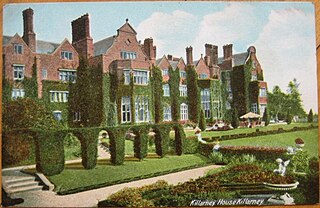
Killarney House is an Irish country home in Killarney, County Kerry, which was built as a replacement for Kenmare House (1726) as the seat of the Earls of Kenmare. The site was chosen by Queen Victoria on her visit to Ireland in 1861.
Valentine Browne, 2nd Earl of Kenmare PC (I), styled Viscount Castlerosse from 1801 to 1812, was Earl of Kenmare and Lord Lieutenant of Kerry. He succeeded Valentine Browne, 1st Earl of Kenmare.

Valentine Charles Browne, 5th Earl of Kenmare, styled Viscount Castlerosse from 1871 to 1905, was an Irish peer who served in the Senate of Southern Ireland, and was Lord Lieutenant of Kerry.

Valentine Edward Charles Browne, 6th Earl of Kenmare, styled Viscount Castlerosse from 1905 to 1941, was the Earl of Kenmare and the son of Valentine Browne, 5th Earl of Kenmare.
Sir Valentine Browne, 1st Viscount Kenmare and 3rd Baronet Browne of Molahiffe (1638–1694), was an Irish Jacobite who fought for James II of England in the Williamite War in Ireland.
The High Sheriff of Kerry was the British Crown's judicial representative in County Kerry, Ireland from the 16th century until 1922, when the office was abolished in the new Free State and replaced by the office of Kerry County Sheriff. The sheriff had judicial, electoral, ceremonial and administrative functions and executed High Court Writs. In 1908, an Order in Council made the Lord-Lieutenant the Sovereign's prime representative in a county and reduced the High Sheriff's precedence. However, the sheriff retained his responsibilities for the preservation of law and order in the county. The usual procedure for appointing the sheriff from 1660 onwards was that three persons were nominated at the beginning of each year from the county and the Lord Lieutenant then appointed his choice as High Sheriff for the remainder of the year. Often the other nominees were appointed as under-sheriffs. Sometimes a sheriff did not fulfil his entire term through death or other event and another sheriff was then appointed for the remainder of the year. The dates given hereunder are the dates of appointment. All addresses are in County Kerry unless stated otherwise.
Sir Valentine Browne, 2nd Baronet, of Molahiffe, was an Irish landowner and MP.
Sir Valentine Browne, 1st Baronet, of Molahiffe, owned a large estate in south-west Ireland and was a lawyer who served as high sheriff of County Kerry.